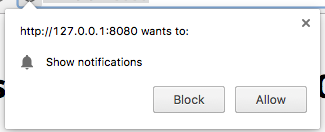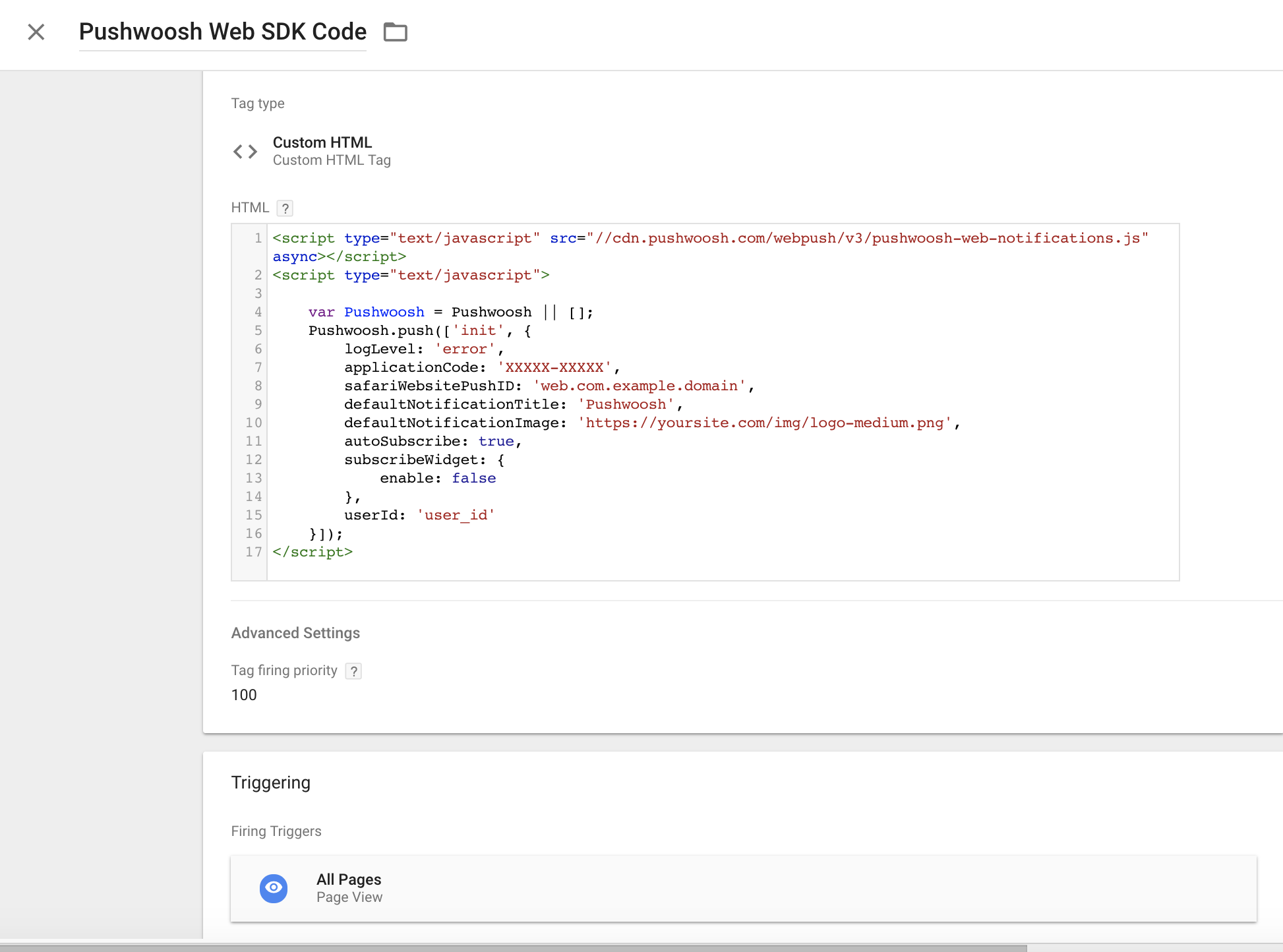Web push SDK 3.0
Integration
Section titled “Integration”Get Pushwoosh Web Push SDK and unzip it. You should have the following files:
Section titled “Get Pushwoosh Web Push SDK and unzip it. You should have the following files:”- pushwoosh-service-worker.js
Place all these files to top-level root of your website directory.
Section titled “Place all these files to top-level root of your website directory.”Initialize the SDK:
Section titled “Initialize the SDK:”- Include the SDK from our CDN asynchronously.
<script type="text/javascript" src="//cdn.pushwoosh.com/webpush/v3/pushwoosh-web-notifications.js" async></script>- Initialize the Web Push SDK and make sure to queue the initialization until the moment the SDK is fully loaded.
<script type="text/javascript">var Pushwoosh = Pushwoosh || [];Pushwoosh.push(['init', { logLevel: 'info', // possible values: error, info, debug applicationCode: 'XXXXX-XXXXX', // you application code from Pushwoosh Control Panel apiToken: 'XXXXXXX', // Device API Token safariWebsitePushID: 'web.com.example.domain', // unique reverse-domain string, obtained in you Apple Developer Portal. Only needed if you send push notifications to Safari browser defaultNotificationTitle: 'Pushwoosh', // sets a default title for push notifications defaultNotificationImage: 'https://yoursite.com/img/logo-medium.png', // URL to custom custom notification image autoSubscribe: false, // or true. If true, prompts a user to subscribe for pushes upon SDK initialization subscribeWidget: { enable: true }, userId: 'user_id', // optional, set custom user ID tags: { 'Name': 'John Smith' // optional, set custom Tags }}]);</script>Configuration
Section titled “Configuration”To finish implementing push notifications into your website, you need to configure web platforms in your Pushwoosh Control Panel following our step-by-step guides:
Registering service worker in a different scope
Section titled “Registering service worker in a different scope”Sometimes you can’t place the service worker file in a root directory of a website but in a subdirectory.
In this case, modify the configuration (step 4.3) by adding a parameter
serviceWorkerUrl: “/push-notifications/pushwoosh-service-worker.js”
where /push-notifications/pushwoosh-service-worker.js is the path to pushwoosh-service-worker.js file.
Event handlers
Section titled “Event handlers”In Pushwoosh Web SDK 3.0 you can subscribe to certain events to track them**,** or unsubscribe from events if don’t need tracking them anymore.
To track the Web SDK 3.0 load, fire the onLoad event as follows:
// Load EventPushwoosh.push(['onLoad', (api) => { console.log('Pushwoosh load!');}]);To track the correct Web SDK initialization, fire the onReady event:
// Ready EventPushwoosh.push((api) => { console.log('Pushwoosh ready!');});To subscribe to or unsubscribe from any of the SDK events, use the handlers after the SDK load:
Pushwoosh.push(['onLoad', (api) => { function onEventNameHandler() { console.log('Triggered event: event-name!'); }
// To subscribe to an event: Pushwoosh.addEventHandler('event-name', onEventNameHandler)
// To unsubscribe from an event: Pushwoosh.removeEventHandler('event-name', onEventNameHandler)}]);SDK events
Section titled “SDK events”Subscribe event
Section titled “Subscribe event”Executed after a user agrees to receive push notifications.
Pushwoosh.push(['onLoad', (api) => { Pushwoosh.addEventHandler('subscribe', (payload) => { console.log('Triggered event: subscribe'); });}]);Unsubscribe event
Section titled “Unsubscribe event”Executed after a device is unregistered from notifications.
Pushwoosh.push(['onLoad', (api) => { Pushwoosh.addEventHandler('unsubscribe', (payload) => { console.log('Triggered event: unsubscribe'); });}]);Subscription widget events
Section titled “Subscription widget events”Track displaying of a Subscription Prompt widget.
Pushwoosh.push(['onLoad', (api) => { // Executed on displaying of the Subscription Prompt widget Pushwoosh.addEventHandler('show-subscription-widget', (payload) => { console.log('Triggered event: show-subscription-widget'); });
// Executed on hiding of the Subscription Prompt widget Pushwoosh.addEventHandler('hide-subscription-widget', (payload) => { console.log('Triggered event: hide-subscription-widget'); });}]);Notification permission dialog events
Section titled “Notification permission dialog events”Track displaying of native subscription dialog.
Pushwoosh.push(['onLoad', function (api) { // Executed on permission dialog displaying Pushwoosh.addEventHandler('show-notification-permission-dialog', (payload) => { console.log('Triggered event: show-notification-permission-dialog'); });
// Executed on hiding the permission dialog with one of three possible statuses: // 1. default - the dialog is closed // 2. granted - permission is granted // 3. denied - permission is denied Pushwoosh.addEventHandler('hide-notification-permission-dialog', (payload) => { console.log('Triggered event: hide-notification-permission-dialog', payload.permission); });}]);Permission events
Section titled “Permission events”Check the push notifications permission’s status on SDK initialization; track the update of this status whenever it takes place.
Pushwoosh.push(['onLoad', (api) => { // Executed during the SDK initialization if 'autoSubscribe: false' or/and if a user ignores a push notification prompt. Pushwoosh.addEventHandler('permission-default', (payload) => { console.log('Triggered event: permission-default'); });
// Executed during the SDK initialization if notifications are blocked or once a user blocks push notifications. Pushwoosh.addEventHandler('permission-denied', (payload) => { console.log('Triggered event: permission-denied'); });
// Executed during the SDK initialization if notifications are allowed or once a user allows push notifications. Pushwoosh.addEventHandler('permission-granted', (payload) => { console.log('Triggered event: permission-granted'); });}]);Receive push event
Section titled “Receive push event”Track push delivery to a device.
Pushwoosh.push(['onLoad', (api) => { // Executed when a push notification is displayed. Pushwoosh.addEventHandler('receive-push', (payload) => { console.log('Triggered event: receive-push', payload.notification); });}]);Notification events
Section titled “Notification events”Track whether a push notification is opened or closed by a user.
Pushwoosh.push(['onLoad', (api) => { // Executed when a user clicks on notification. Pushwoosh.addEventHandler('open-notification', (payload) => { console.log('Triggered event: open-notification', payload.notification); });
// Executed when a user closes a push notification. Pushwoosh.addEventHandler('hide-notification', (payload) => { console.log('Triggered event: hide-notification', payload.notification); });}]);Inbox events
Section titled “Inbox events”Track notifications sent to Inbox.
Pushwoosh.push(['onLoad', (api) => { // Executed by ServiceWorker after the Inbox Message is received and saved to indexedDB. Pushwoosh.addEventHandler('receive-inbox-message', (payload) => { console.log('Triggered event: receive-inbox-message', payload.message); });
// Executed after the Inbox is updated automatically while the page is loading. Pushwoosh.addEventHandler('update-inbox-messages', (payload) => { console.log('Triggered event: receive-inbox-message', payload.messages); });}]);Custom subscription popup events
Section titled “Custom subscription popup events”For details about handling custom subscription popup events, please refer to the Custom Subscription Popup Events Guide.
After the Web Push SDK is initialized, you can make the following calls to Pushwoosh API. All the methods return Promise objects.
Pushwoosh.push((api) => { // Set tags for a user api.setTags({ 'Tag Name 1': 'value1', 'Tag Name 2': 'value2' });
// Get tags for a user from server api.getTags();
// Register user ID api.registerUser('myUserID');
// Register user email api.registerEmail('<user_email>');
// Post an Event api.postEvent('myEventName', {attributeName: 'attributeValue'});
//Unregister from notifications api.unregisterDevice();});Example of sending Tags to Pushwoosh:
Pushwoosh.push((api) => { var myCustomTags = { 'Tag 1': 123, 'Tag 2': 'some string' }; api.setTags(myCustomTags) .then((res) => { var skipped = res && res.skipped || []; if (!skipped.length) { console.log('success'); } else { console.warn('skipped tags:', skipped); } }) .catch((err) => { console.error('setTags error:', err); });});Increment Tag value
Section titled “Increment Tag value”To increment a value of a Number Tag, use the operation parameter with the ‘increment’ value as follows:
Pushwoosh.push((api) => { api.setTags({ 'Tag 1': { operation: 'increment', value: 1 } })});Append Tag values
Section titled “Append Tag values”To append new values to the existing List Tag, use the operation parameter with the ‘append’ value as follows:
Pushwoosh.push((api) => { api.setTags({ 'Tag 3': { operation: 'append', value: ['Value3'] } })});Remove Tag value
Section titled “Remove Tag value”To remove a value from a List Tag, use the operation parameter with the ‘remove’ value as follows:
Pushwoosh.push((api) =>{ api.setTags({ 'Tag 3': { operation: 'remove', value: ['Value2'] } })});Public methods
Section titled “Public methods”Pushwoosh.subscribe()
This method is used to request a user’s permission for push notifications. If a user is already subscribed, the method will stop executing.
If a user hasn’t subscribed for pushes yet:
1. Permission for push notifications is requested.

2. If a user allows notifications, onSubscribe event is triggered.
Pushwoosh.subscribe() is executed automatically if autoSubscribe: true. is set during the SDK initialization.
Call this method if you have chosen to manually prompt a user to subscribe for pushes using the autoSubscribe: false parameter during the initialization:
<button onclick="Pushwoosh.subscribe()">Subscribe</button><script> Pushwoosh.push(['onSubscribe', (api) => { console.log('User successfully subscribed'); }]);</script>Pushwoosh.unsubscribe()
/unregisterDevicemethod is executed.onUnsubscribeevent is triggered.
<button onclick="Pushwoosh.unsubscribe()">Unsubscribe</button><script type="text/javascript"> Pushwoosh.push(['onUnsubscribe', (api) => { console.log('User successfully unsubscribed'); }]);</script>Pushwoosh.isSubscribed()
Checks if a user is subscribed and returns true/false flag.
Pushwoosh.isSubscribed().then((isSubscribed) => { console.log('isSubscribed', isSubscribed);});Pushwoosh.getHWID()
Returns Pushwoosh HWID.
Pushwoosh.getHWID().then((hwid) => { console.log('hwid:', hwid);});Pushwoosh.getPushToken()
Returns push token if it is available.
Pushwoosh.getPushToken().then((pushToken) => { console.log('pushToken:', pushToken);});Pushwoosh.getUserId()
Returns User ID if available.
Pushwoosh.getUserId().then((userId) => { console.log('userId:', userId);});Pushwoosh.getParams()
Returns a list of the following parameters:
Pushwoosh.getParams().then((params) => { params = params || {}; var hwid = params.hwid; var pushToken = params.pushToken; var userId = params.userId;});Pushwoosh.isAvailableNotifications()
Checks if a browser supports the Pushwoosh WebSDK 3.0, returns ‘true’ or ‘false’.
Pushwoosh.isAvailableNotifications() // true/falseInboxMessages methods
Section titled “InboxMessages methods”messagesWithNoActionPerformedCount(): Promise<number>
Returns the number of opened messages.
Pushwoosh.pwinbox.messagesWithNoActionPerformedCount() .then((count) => { console.log(`${count} messages opened`); });unreadMessagesCount()
Returns the number of unread messages.
Pushwoosh.pwinbox.unreadMessagesCount() .then((count) => { console.log(`${count} messages unread`); });messagesCount(): Promise<number>
Returns the total number of messages.
Pushwoosh.pwinbox.messagesCount() .then((count) => { console.log(`${count} messages`); });loadMessages(): Promise<Array>
Loads the list of undeleted messages.
Pushwoosh.pwinbox.loadMessages() .then(() => { console.log('Messages have been loaded'); });readMessagesWithCodes(codes: Array<string>): Promise<void>
Marks messages as read by Inbox_Ids.
Pushwoosh.pwinbox.readMessagesWithCodes(codes) .then(() => { console.log('Messages have been read'); });performActionForMessageWithCode(code: string): Promise<void>
Performs the action assigned to a message and marks the message as read.
Pushwoosh.pwinbox.performActionForMessageWithCode(code) .then(() => { console.log('Action has been performed'); });deleteMessagesWithCodes(codes: Array<string>): Promise<void>
Marks messages as deleted.
Pushwoosh.pwinbox.deleteMessagesWithCodes([code]) .then(() => { console.log('Messages have been deleted'); });syncMessages(): Promise<void>
Synchronizes messages with the server.
Pushwoosh.pwinbox.syncMessages() .then(() => { console.log('Messages have been synchronized'); });Progressive Web App support
Section titled “Progressive Web App support”To integrate Pushwoosh into your Progressive Web Application (PWA), follow the steps described below.
1. Copy the path to your Service Worker file:
if ('serviceWorker' in navigator) { window.addEventListener('load', () => { navigator.serviceWorker.register('/service-worker.js') // <- your service worker url });}Then, use the serviceWorkerUrl parameter while initializing the WebSDK as follows:
var Pushwoosh = Pushwoosh || [];Pushwoosh.push(['init', { logLevel: 'error', applicationCode: 'XXXXX-XXXXX', safariWebsitePushID: 'web.com.example.domain', defaultNotificationTitle: 'Pushwoosh', defaultNotificationImage: 'https://yoursite.com/img/logo-medium.png', serviceWorkerUrl: '/service-worker.js', // <- your service worker url}]);WebSDK does not register the new Service Worker immediately; a Service Worker is registered when it’s needed:
- when a device receives a push token (on device registration or re-subscription),
- when a push token is deleted (on removing a device from user base).
It speeds your pages loading by shortening the number of server requests.
Browsers do not allow two different Service Workers to be registered at the same time (read more: https://github.com/w3c/ServiceWorker/issues/921), so to make your PWA work correctly, a common Service Worker should be registered for your codebase and the Pushwoosh codebase.
2. Add the following string to your Service Worker (at the beginning or at the end of, it doesn’t matter):
importScripts('https://cdn.pushwoosh.com/webpush/v3/pushwoosh-service-worker.js' + self.location.search);Thus you enable receiving and processing of push notifications sent via Pushwoosh services for your Service Worker.
Installing from Google Tag Manager
Section titled “Installing from Google Tag Manager”Use the following code in your Google Tag Manager to initialize Pushwoosh SDK. Create a Custom HTML Tag and paste the code below. Make sure to change your Pushwoosh Application Code, Safari Website ID, and default notification image URL.
Also set high Tag Firing priority (ex: 100) and trigger it on All Pages. See below for a screenshot.Copy
<script type="text/javascript" src="//cdn.pushwoosh.com/webpush/v3/pushwoosh-web-notifications.js" async></script><script type="text/javascript"> var Pushwoosh = Pushwoosh || []; Pushwoosh.push(['init', { logLevel: 'error', applicationCode: 'XXXXX-XXXXX', safariWebsitePushID: 'web.com.example.domain', defaultNotificationTitle: 'Pushwoosh', defaultNotificationImage: 'https://yoursite.com/img/logo-medium.png', autoSubscribe: true, subscribeWidget: { enable: false }, userId: 'user_id' }]);</script>